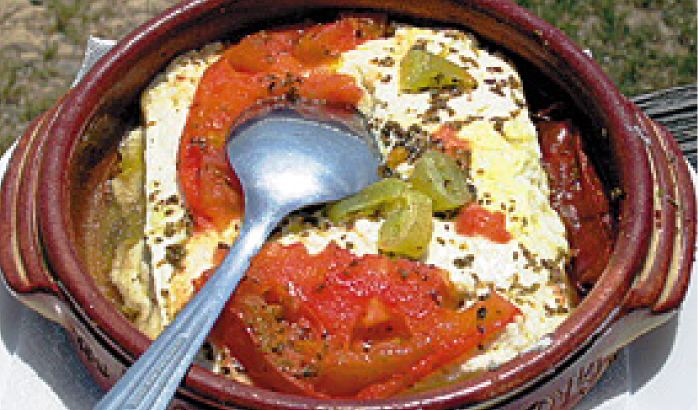 |
||
|
The Greek Cheeses |
||
|
Feta - Sheep's milk cheese
FETA is the glorious star in Greek cuisine, whether you visit a well known town restaurant or the most inexpensive tavern in a lonesome province village. You can enjoy a piece of feta out of the oven, the warm variety of a Greek meze, but also directly out of the refrigerator on very hot summer days. Sheep's milk cheese is a staple food and a typical Greek family enjoys an average of 220 pounds (100 kilograms) each year. As a result, there are is a small concern throughout the country of meeting local demand. As is typical of Greece, the flavour of |
 |
|
|
the sheep's milk cheese varies from region to region, but each producer swears by their own product and has their own loyal customers who will buy large quantities of the cheese they need only from them, their favourite vendor. The word feta means a slice or a piece and refers to the way the curds are treated during the manufacturing process. Feta is not associated with any specific type of sheep's milk.
Make it on your own In the countryside, you can still find housewives who make their own sheep's milk cheese, albeit in smaller quantities. Two and a half gallons (10 litres) of non pasteurised milk are poured into a bowl through a closely woven cotton cloth. The temperature of the milk should be between 61°F (16°C) and 64° F (18°C). Although lactic acid bacteria on their own would separate the milk proteins, the process is accelerated and improved by adding rennet (from calves' stomachs). For two and a half gallons (10 litres) of milk you will need no more than one teaspoon of rennet, mixed with a little milk before being added to the bowl and carefully stirred. Cover the bowl with a cloth and leave the milk to stand for about one hour. Line a strainer with a cheesecloth, and then pour in the thickened milk, the curds, allowing the whey to drain off. After about four hours, slice the remaining curds in the cloth to release more whey, then layer the slices in a large, airtight Container, sprinkling each layer of cheese with sufficient salt. People typically ration about 1 pound (450 grams) of salt to 18 pounds (8 kilograms) of cheese. The cheese can be eaten even in this soft, fresh condition, but as time goes by the salt continues to draw out more liquid, making the cheese more compact. After about 60 days, the cheese will have completed the first maturing stage. Freshly prepared sheep's milk cheese can be stored in a cool place for about two years. The older it is, the more advisable it is to rinse it under running water before eating. Kali Orexi! A guide to Greek cheese Typical Greek cheese shops sell many different local types of cheese, made from sheep's, goat's or cow's milk. Sometimes feta is still stored in the traditional wooden barrels. Anthotiros - Similar to mizithra; soft and unsalted with a full fat content (Crete) Batzos - Sweet-sour, semi hard cheese made from sheep's or goat's milk (Naousa/Macedonia) Challoumi (Halloumi) - Spicy, high fat content hard cheese (Cyprus) Feta Soft - or slightly crumbly white sheep's milk cheese (Various regions) Formailla - Strong, cylindrical hard cheese made from sheep's milk (Parnassos) Galotiri - Very strong, white, easily spread soft cheese (Thessaly) Graviera - Aromatic hard cheese made from cow's milk, similar to Swiss cheese (Various regions) Kasseri - Semi hard slightly tangy, yellow-white sheep's milk cheese (Various region) Kathoura - Soft goat's milk cheese similar to mozzarella (Ikaria) Kefalograviera - Tangy, pale yellow hard cheese made from cow's or sheep's milk (Various regions) Kefalotiri - Tangy, salty hard cheese made from sheep's or goat's milk (Various regions) Kloro - Soft cheese from sheep's or goat's milk; khioro' vinsanto is preserved in wine (Santorini) Kopanisti - Tangy, easily spread blue-veined sheep's milk cheese (Cyclades) Krasotiri Gilomeno - Hard sheep's milk cheese preserved in wine (Dodecanese) Ladotiri - Hard cheese matured in oil (Zakinthos) Manouri - Mild, soft sheep's milk cheese (Various regions) Metsovone - Smoked hard cheese (Metsovon) Mizithra - Soft sheep's milk cheese similar to manouri (Chios) Petroto - Hard cow's milk cheese pressed between two stones (Tinos) Pretza - Creamy, very strong soft cheese (Zakinthos) San Michali - Tangy hard cheese made from cow's milk (Syros) Sfelia - Strong cheese made from sheep's or goat's milk (Peloponnese) Telemes - Like feta, but made from cow's milk (Various regions) Tiri Tiraki - Cow's milk cheese (Tinos) Touloumotiri - Strong soft cheese made from goat's milk (East Aegean) Xinomizithra - A type of high fat Cottage cheese, usually tangy and salty (Cyclades) * Marianthi Miloma is the author of the book Culinaria Greece |
||
(Posting date 18 January 2008)
All articles of Athens News appearing on HCS have been reprinted with permission. |
||
|
||
|
2000 © Hellenic Communication Service, L.L.C. All Rights Reserved. http://www.HellenicComServe.com |
||

